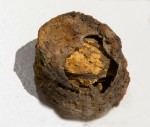#History |
Synchrotron X-ray imaging virtually opens mystery box Posted: 06 Nov 2015 08:54 PM PST A badly corroded box found in a 17th century tomb has been virtually opened by powerful synchrotron X-ray imagining and its contents revealed in exceptional high resolution. The box and its contents are not so portentous, archaeologically speaking, but the phenomenal quality of the imaging opens up a whole new world of possibilities. The metal box was found in one of more than 1,500 tombs unearthed under the old Saint-Laurent church which is now the Grenoble Archaeological Museum. The site has been in use since the 4th century when it was a cemetery outside the ancient city. Starting with a cruciform church in the 6th century, buildings were constructed on top of the remains of earlier buildings in four known stages. The current Saint-Laurent building is a 12th century Romanesque church that was deconsecrated in 1986 and converted into the museum.
More than 2,000 artifacts have been discovered in the tombs, many of which are on display in the museum which beautifully weaves the open excavated crypts into exhibition space. The box was found buried next to a body in a group of 195 graves from the 17th centuries. It’s a tiny piece — just 4 centimeters (an inch and a half) in diameter — and is so fragile conservators decided to restore it only to the point of stopping the oxidation process that was eating away its metal. Because corrosion had worn a hole in the lid, they could see that there were three round coin-like objects inside, but couldn’t make out any further details.
The scanner found that the “coins” inside were actually clay religious medals. There were also two pearls inside the box. The medallions were stuck together and in bad condition, but the synchrotron X-ray was able to virtually separate them and make a 3D virtual model so crisp and detailed it has to be seen to be believed. Behold: The imaging is far better than anything we can see with our puny human eyeballs so markedly inferior to those of any cephalopod. We now know that there are two identical medals sandwiching a different one between them. The middle medal, which has the most surviving detail, depicts Christ on the cross with two figures — probably Mary Magdalene and the Virgin Mary — standing on either side. The other side of the medal shows Christ wearing the crown of thorns, rising from the tomb with one leg out of the coffin and holding the standard of the Resurrection and Victory. The other two medals were both more damaged, but fortunately in different places so it was possible to use the image of one medal to fill in the blanks on the other. One side shows the baptism of Christ and bears an inscription from John 1:14 VERBUM CARO, FACTUM EST (“And the word was made flesh”). The other side is a Nativity scene, with the Magi bringing gifts to the baby Jesus on Mary’s lap. The inscription is the opening line of Psalm reads of the medal shows the three Magi bringing gold, frankincense and myrrh to the infant Jesus seated on Mary's lap. The presence of Joseph behind Mary can be assumed but the state of preservation of the medals does not allow confirmation. The inscription is a verse recited during the Stations of the Cross: ADORAMUS TE, CHRISTE ET BENEDICIMUS TIBI (“We adore Thee, O Christ, and we bless Thee”). |
| You are subscribed to email updates from The History Blog. To stop receiving these emails, you may unsubscribe now. | Email delivery powered by Google |
| Google Inc., 1600 Amphitheatre Parkway, Mountain View, CA 94043, United States | |


